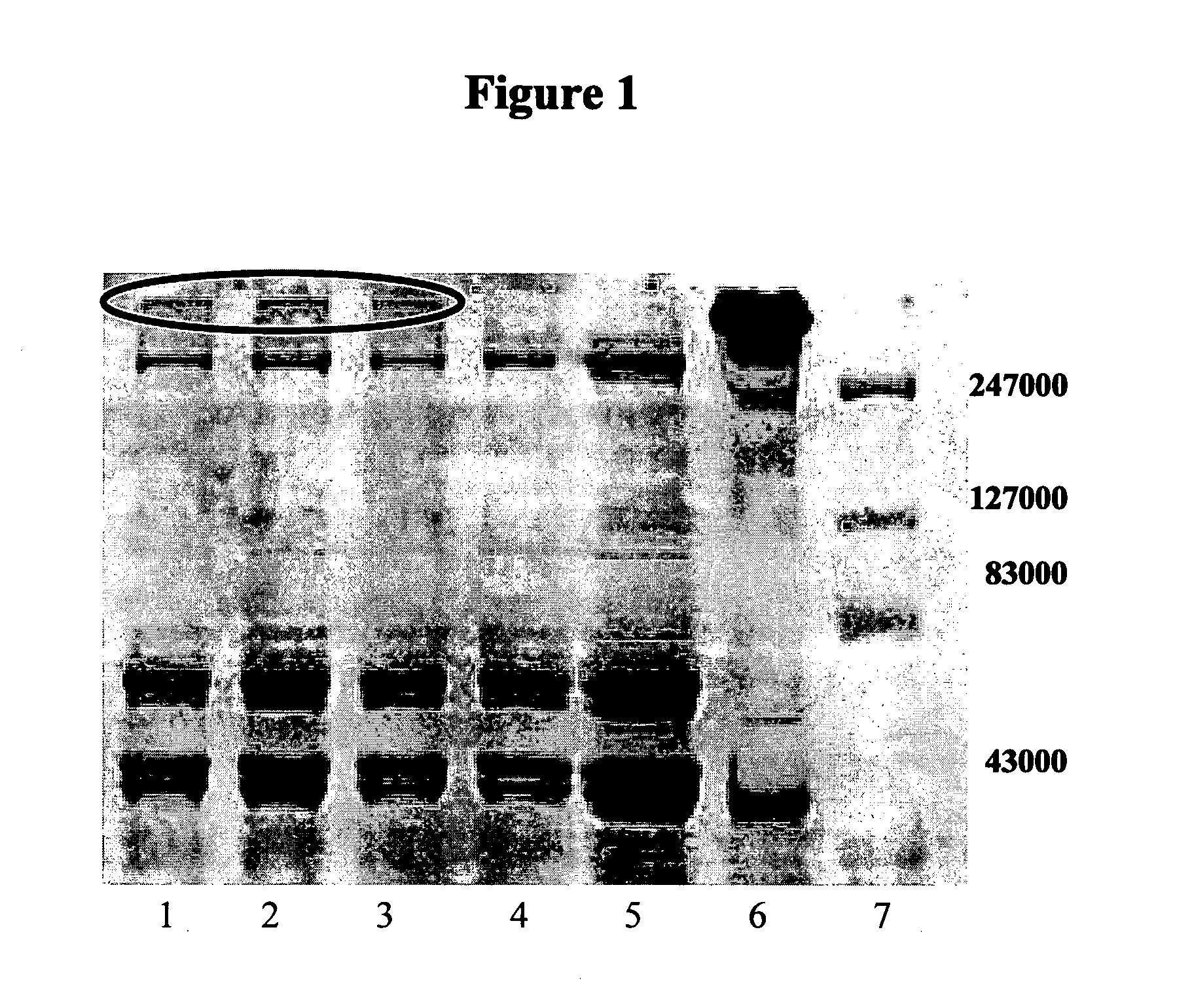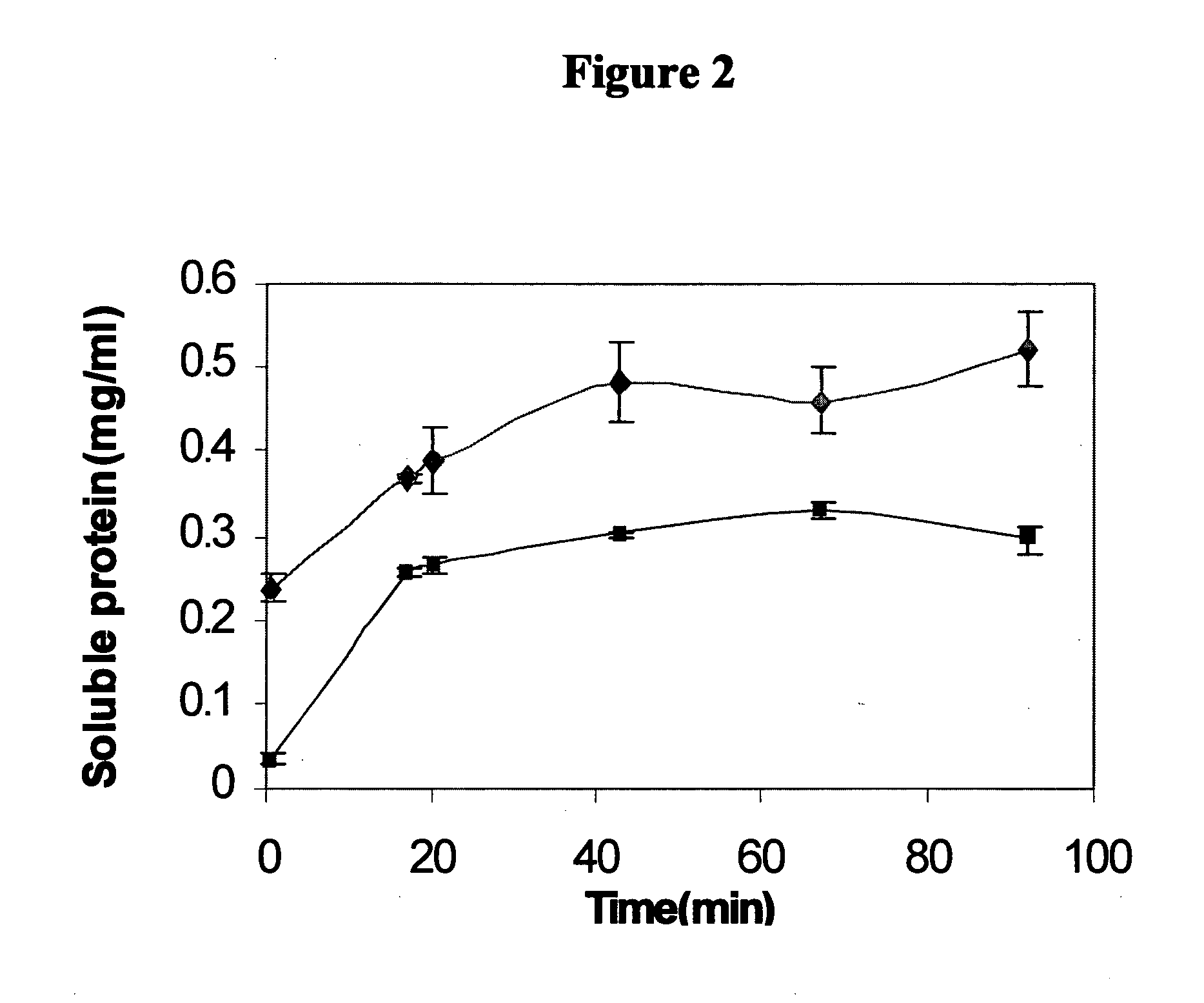Water soluble reactive derivatives of carboxy polysaccharides and fibrinogen conjugates thereof
a technology of carboxy polysaccharides and reactive ester derivatives, which is applied in the direction of fibrinogen, peptide/protein ingredients, drug compositions, etc., can solve the problems of limiting the conjugation reaction to proteins or polypeptides miscible in aprotic solvents, and no method whatsoever is disclosed for forming chemical conjugates between ha and fibrinogen, so as to prevent the production of undesired side products and high yield
- Summary
- Abstract
- Description
- Claims
- Application Information
AI Technical Summary
Benefits of technology
Problems solved by technology
Method used
Image
Examples
example 1
Attempts to Synthesize a Water-Soluble HA-Fibrinogen Conjugate
[0170]Two attempts to prepare a water-soluble conjugate of fibrinogen and HA were made following a “one pot” procedure or a two-step procedure. The first attempt was as follows:
[0171]EDC (6 mg, 0.031 mmols) and NHS (3.6 mg, 0.031 mmols) were added to a mixture of HA (4 mg, 0.01 mmols carboxylic groups) and fibrinogen (72 mg) in PBS (3 ml). The clear solution was gently rotated for 60 minutes at room temperature (RT). A heavy precipitate was obtained presumably, without being bound by any mechanism of action, due to a side reaction in which EDC cross-linked fibrinogen molecules as well as conjugate molecules intermolecularly.
[0172]A second unsuccessful attempt to prepare a water-soluble conjugate of fibrinogen and HA via a two-step reaction was made, as follows:
[0173]EDC (6 mg, 0.031 mmols) and NHS (3.6 mg, 0.031 mmols) were added to a solution of HA (4 mg) in water (1 ml). The clear solution was gently rotated at RT for 6...
example 2
Removal of Residual EDC, Following Activation of HA
[0174]EDC (6 mg, 0.031 mmols) and NHS (3.6 mg, 0.031 mmols) were added to a solution of HA (4 mg) in 1.5 ml buffer MES (50 mM, pH 5.5). The clear mixture was gently rotated for 60 min. A water insoluble resin (Amberlite® IRC-50, Na+ form, 100 mg) was then added and the mixture was further rotated for 15 min. The resin was separated from the reaction mixture by centrifugation and the amount of EDC in the supernatant was determined following a published procedure (Gilles et al., 1990). The amount of EDC was found to be less than 0.2 μg / ml, which is the lowest detection limit of the above-mentioned procedure.
[0175]In a control experiment, in which no insoluble resin has been used, 1.13 mg / ml of EDC remained in the reaction mixture.
example 3
Synthesis of a Water-Soluble Conjugate of Fibrinogen and HA Via a Two-Step Procedure
[0176]Step 1: EDC (6 mg, 0.031 mmols) and NHS (3.6 mg, 0.031 mmols) were added to a solution of HA (4 mg, 0.01 mmols carboxylic groups) in 1.5 ml buffer MES (50 mM, pH 5.5). The clear mixture was gently rotated at RT for 60 minutes. The resin IRC-50 (Na+ form, 100 mg) was then added and the mixture was further rotated for 15 minutes, after which it was centrifuged for 30 seconds to separate the insoluble resin from the activated HA solution.
[0177]Step 2: The activated solution obtained in step 1, was added to a solution of fibrinogen (72 mg) in 1.5 ml buffer MOPS (200 mM, pH 7.5) and the clear reaction mixture was gently rotated for 2 hours. The soluble conjugate thus obtained was further purified by exhaustive dialysis against saline (0.9% NaCl). The conjugate solution of a final 2.8 ml volume, was stored at 4° C. and used as a stock solution for following experiments.
PUM
| Property | Measurement | Unit |
|---|---|---|
| molecular weights | aaaaa | aaaaa |
| molecular weights | aaaaa | aaaaa |
| molecular weight | aaaaa | aaaaa |
Abstract
Description
Claims
Application Information
 Login to View More
Login to View More - R&D
- Intellectual Property
- Life Sciences
- Materials
- Tech Scout
- Unparalleled Data Quality
- Higher Quality Content
- 60% Fewer Hallucinations
Browse by: Latest US Patents, China's latest patents, Technical Efficacy Thesaurus, Application Domain, Technology Topic, Popular Technical Reports.
© 2025 PatSnap. All rights reserved.Legal|Privacy policy|Modern Slavery Act Transparency Statement|Sitemap|About US| Contact US: help@patsnap.com



